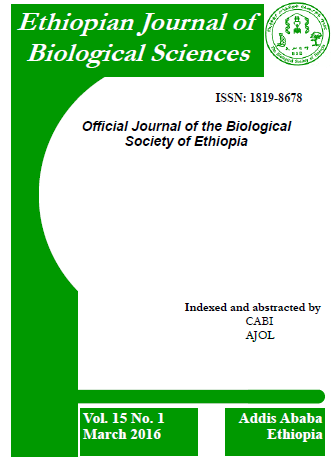ECOLOGICAL TRAITS PREDICT THE SUSCEPTIBILITY OF AFROMONTANE GRASSLAND BIRD SPECIES TO LIVESTOCK GRAZING IN THE BALE MOUNTAINS, ETHIOPIA
Abstract
Conversion of natural habitats to cultivation and grazing lands are among the major threats to biodiversity globally. However, different species of plants and animals respond differently to such land use change, possibly related to their species-specific ecological traits. Using available information on species-specific ecological traits of Afromontane grassland birds occurring in the Bale Mountains of Ethiopia, we predicted the susceptibility of 32 bird species to livestock grazing. We also collected data (along transects) on abundance of these species in 2014 in livestock grazed and ungrazed sites of the northern Afromontane grassland of the Bale Mountains. Using Generalized Linear Model, we then tested the effects of five species’ ecological traits (habitat preference, substrate use, dietary requirements, migratory status and body size) on the observed responses; i.e., whether species predicted to decrease in abundance in the grazed site actually decreased and vice-versa. Our findings show that most of species’ observed responses to grazing were found to concord with the predictions. However, only habitat and substrate preference traits had significant effects on the observed responses. Species preferring tall grass or shrubby vegetation as their primary habitat or foraging substrate preference were less abundant in the grazed site. This approach enables managers to identify which species are most likely to be affected by over-grazing and can be used to guide proactive management decisions. Further, this is the first study of its kind conducted in the internationally important Bale Mountains and the findings here are further transferable to many similar areas across the globe.
Downloads
References
Addisu Asefa (2011). Mammals of the Bale Mountains National Park, Ethiopia: A compiled and annotated checklist. Walia-Special Edition on the Bale Mountains: 3–14.
Addisu Asefa Mitiku (2013). Afromontane Avian Assemblages and Land Use in the Bale Mountains of Ethiopia: Patterns, Processes and Conservation Implications. M.Sc. Thesis, University of Pretoria, Pretoria.
Addisu Asefa and Kinahan, A.A. (2013). Observations on two nests of the black-headed siskin Serinus nigriceps in the Bale Mountains National Park, Ethiopia. Scopus 32(2): 52–54.
Addisu Asefa, Girma Mengesha, Anteneh Shimelis and Yosef Mamo (2015). Livestock grazing in Afromontane grasslands in the northern Bale Mountains, Ethiopia: Implications for bird conservation. Sci. Technol. Arts Res. J. 4(2): 112–121.
Alkemade, R., van Oorschot, M., Miles, L., Nellemann, C., Bakkenes, M. and ten Brink, B. (2009). GLOBIO3: A framework to investigate options for reducing global terrestrial biodiversity loss. Ecosystems 12: 374–390.
More inside the PDF
